Once upon a time, I had no idea what I wanted to be when I grew up. I knew I liked to travel, but it took years before the lightbulb came on for me to apply to my first airline.
During those years, I dipped my toes into a lot of different fields and worked as a bartender, surgical assistant, and even a yoga instructor! When the time had finally come to submit a resume for my forever career, I was nervous that my all-over-the-map experience wasn’t sufficient for a career in the airlines.
But it was actually quite the contrary! Fortunately for me (and everyone else who has never worked in the airlines), it’s not necessary to have experience as a flight attendant to be a flight attendant.
In fact, my experience exemplified qualities that airlines actually look for, such as customer service, hospitality, and a background in safety. Crew members come from many various work backgrounds including retail, food and beverage, teaching, military, health care, and so many other places.
So, where does one begin? We’ll need to build a solid resume!
Let’s explore key tips, writing techniques, and real examples to guide you in creating a compelling flight attendant resume, even with no prior experience!
TL;DR: Even without direct experience, you can craft an effective flight attendant resume. Draw from diverse past roles like bartending or healthcare to highlight customer service and safety skills. Focus on a clean, professional resume layout, keeping job descriptions concise. A single-page resume is ideal, with correct spelling and grammar. Personalize your resume for different airlines using keywords from their job descriptions and core values. Emphasize transferable skills, adaptability, and a passion for aviation. Lastly, a cover letter can add a personal touch and explain any employment gaps, tailored to each airline you apply to.
Table of Contents
My Tips For Writing The Best Flight Attendant Resume
➡️ Prioritize Cleanliness and Professionalism in Your Resume Design
I realize that it’s common advice to hear that a resume needs to stand out. This might be applicable in other fields of work.
However, it’s not terribly realistic when applying to a major airline and thousands of other resumes are being submitted at the same time (For example, Southwest has, in the past, received up to 30,000 resumes per hiring window.)
So instead of focusing on being unique and over-the-top, it’s more important to focus on cleanliness and professionalism. A clean resume will catch an eye over a resume that is cluttered and overloaded with information.
So, what does a clean resume look like? First, I would recommend not getting bogged down with details like multiple colors and fonts. Stick to one font style, one font color, and 1-2 font sizes for the entire page, and avoid going too bold or italics crazy.
Second, in order to avoid clutter, try not to go overboard using special characters like bullet points or dashes. Emojis are cute, but they don’t exactly scream professionalism.
Third, when you are listing your job duties, try to keep them straight to the point. They shouldn’t look like small paragraphs or go over one line. You will have a chance to elaborate on your experience in the cover letter or during the interview. Once again, the focus of the resume should be clean, direct, and minimalistic.
Additionally, consider using our resume templates. These templates can help you maintain a clean and professional appearance, making it easier to craft a visually appealing and effective resume. Plus, the matching cover letter is included.
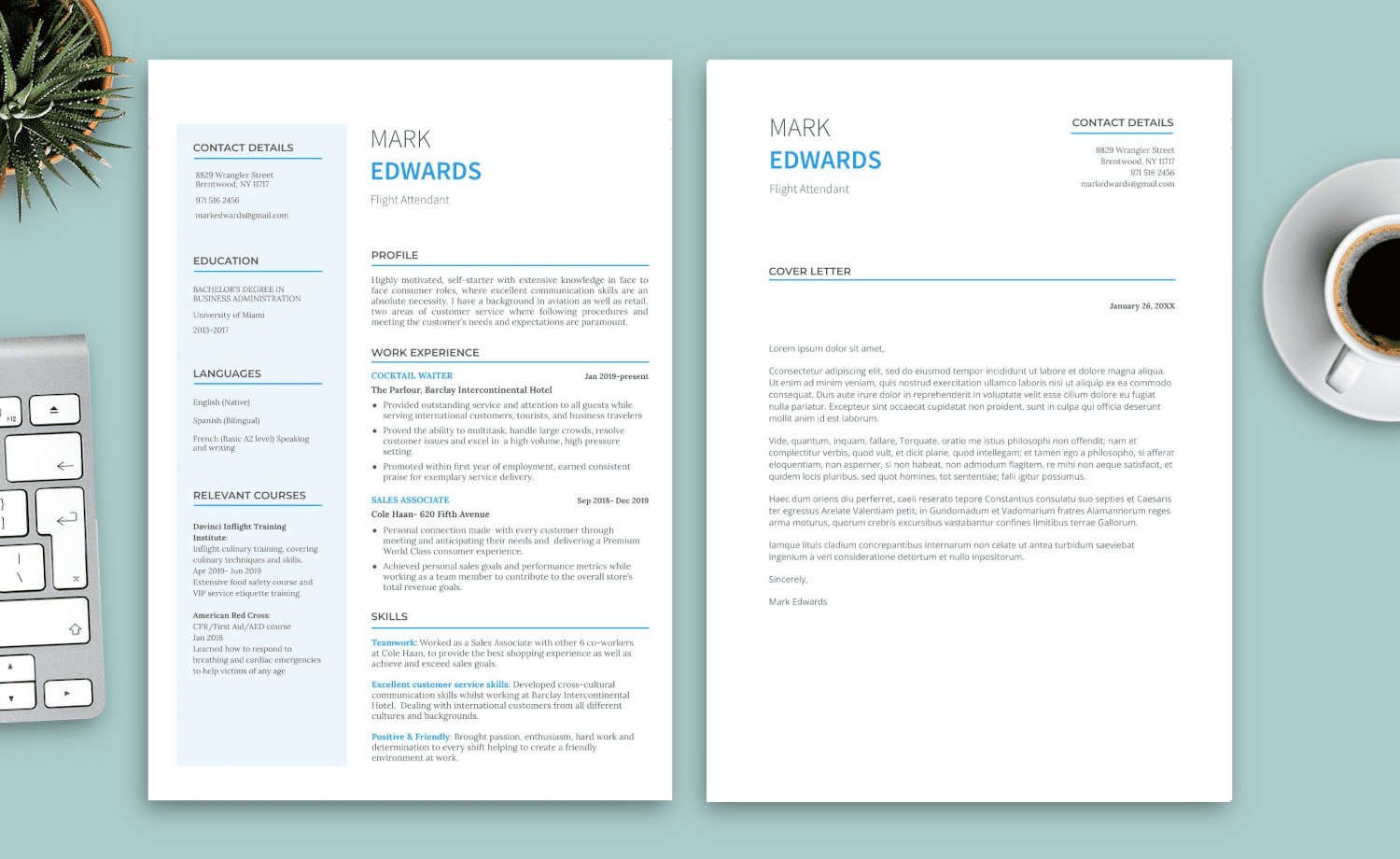
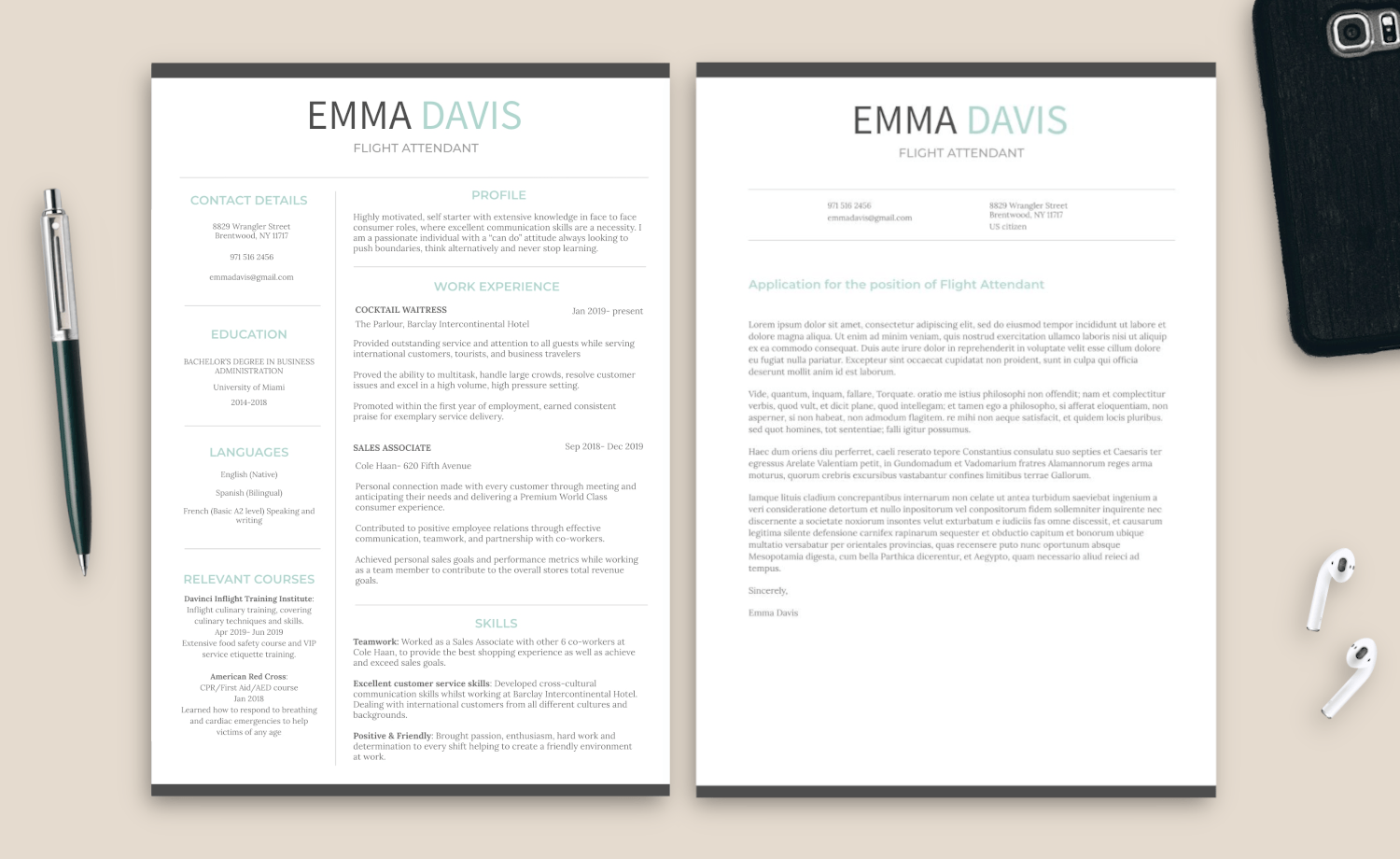
➡️ Keep it Concise
If you can keep your resume to a single page, that would be ideal. If not, that’s okay, but if it goes past two pages, there’s too much information and should be cut down a bit.
➡️ Spelling and Grammar
It takes almost zero precious time to run a spell check, so be thorough! Check your spelling and grammar. If your resume has errors, recruiters will quickly come to the conclusion that you lack attention to detail.
➡️ Seek Peer Review
If your English or grammatical skills are not strong, it could be beneficial to have it double-checked by a native speaker or even a friend who has a knack for writing resumes.
➡️ Be Honest
Chances are, you already have the skills needed to be a flight attendant! So, it’s really not necessary to fabricate. Instead, lean into your strengths and really emphasize those points.
➡️ Minimize Employment Gaps: Present a Coherent History
If you have gaps in your employment history, try to fill them in the best you can.
Can you add that you were volunteering during that time?
Were you traveling or in school or helping a sick loved one?
It’s okay, but be ready to explain those gaps in a cover letter or the interview.
➡️ File Format Matters: Use PDF
If you are submitting your resume online, send it in PDF format. It’s the safest bet, as not all systems can read other formats.
Others might be troublesome to open and also not be displayed on the screen in the same way it was intended to be shown.
➡️ Filename
It helps to use an appropriate and clear resume filename. This will be easier for you to locate it anytime you need to pull it up, and also be clear for the employer to find it easily.
For example, use your first and last name: John-Harrison.pdf
➡️ Follow Instructions Precisely
Follow the instructions given.
These days, airlines always have you submit a resume online through their careers website. It won’t be difficult to follow their instructions as it basically just entails a resume upload, but be sure to read everything on the careers page to not miss out on any key details.
For example, they might require that the applicant have a valid passport by the time of the interview date.
➡️ Include ATS Keywords
If you have no idea what I’m talking about don’t worry, I’ll explain!
ATS stands for “applicant tracking system”.
Basically, airlines receive so many resumes at once that it’s almost impossible for a team of recruiters to keep track.
Tools like ATS can scan a big pile of submissions and pick out resumes based on keywords. Here’s the best way to maximize use of ATS keywords…
First, check out the careers website of a given airline. You’ll likely find a section that includes a detailed description of what the job entails and the duties.
For example:
“Flight attendants will be responsible for greeting and assisting passengers during boarding.”
I made that one up, but it will be something along those lines. So, if you worked in a restaurant, you can easily use these keywords in reference to your own previous job duties!
What were you “responsible” for? Did you “greet” guests at the door or at the bar or a table?
Whatever you do, do not copy and paste phrases. If the keywords are in context, then the resume will flow nicely.
Hot tip #1 🚨 : While being a flight attendant is a partly a service position, it MOSTLY is a safety position! Emphasis on any safety-related duties performed at previous jobs will be very helpful in giving an applicant a leg up during the hiring process.
How else can you utilize ATC keywords?
Take a look at the company core values section of the airline’s website! Those are brimming with buzzwords to use in your resume. This is also a good way to show that your values and their values align. In addition, it will help to diversify your resumes if you are applying to different airlines
How do I Write a Good Flight Attendant Resume Without Experience?
1. Emphasize Relevant Skills
The biggest qualifier to the flight attendant position is customer service experience. The reason is because we are dealing with the public…
All. Day. Long.
From the passengers who come onto our working flights, to the random people in the airport terminal who ask you for directions to baggage claim while standing under the baggage claim sign, to the shuttle drivers who want to tell you all about their cousin who’s a flight attendant for so-and-airline…
Realistically, it can get mentally and emotionally exhausting! It will benefit you to have a little exposure under your belt in situations like providing exceptional service, connecting with people of diverse backgrounds, and conflict resolution.
Whether you realize it or not, you probably already have customer service experience in some way, shape, or form.
Here are some common positions that include experience in customer service:
- Public service positions (military, police officers, politics, not-for-profit work)
- Restaurant industry
- Health care
- Retail
- Sales
- Marketing
- Teaching or translating
- Administrative office work
And so many more.
But even if you’re sure you have no customer service experience, you can still land the job!
By showcasing your enthusiasm to work with the public and your personal strengths as an empathetic, compassionate, and positive person, you will still be a strong and viable candidate as a flight attendant!
2. Highlight Transferable Skills from Related Fields
Did you know that being a flight attendant is, first and foremost, a safety position?
It’s probably good if you don’t because we don’t actually ever want to have to use our primary training!
However, things do happen (if you’re curious, just run a Google search for “Miracle on the Hudson” and read all about how a flight can become a cruise in a short amount of time), so safety and emergency training is a huge factor.
Common relevant positions include:
- Hospital work
- EMT
- Paramedic
- Military
- Firefighting experience.
If you have experience in any of these fields, I highly recommend adding them to your resume.
Don’t forget to include any CPR or medical training certifications/licenses.
3. Showcase Your Passion for Aviation
Have you always had an interest in aviation? There are ways to share this on your resume!
Even if you’re applying for a flight attendant position, you can still include any flight training you may have had or interest in future pilot training.
Airlines are happy to accept flight attendants who have future plans for flight school. In fact, they’ll even help put them on track either by setting them up with their own company’s flight school partners or if they don’t offer that, pointing them in the right direction to eventually get that commercial license.
Try to keep this section of your resume brief and to the point.
If you have no flight school experience, the best place to mention your long-time interest in aviation is on the cover letter.
4. Tailor Your Resume to Specific Airlines
Along with your cover letter, you should diversify your resumes by tailoring each one to each individual airline you apply to.
They don’t have to be completely different!
However, a good recommendation would be to check out the “core values” page on each airline’s website.
Knowing the unique culture, values and target clientele of each company can help you decide what kind of buzzwords you want to use in your resume, and also set a specific tone for your cover letter.
What to Include in a Flight Attendant Resume? Key Sections
1. Contact details
Even though you will also be providing this information through the careers page, it still looks professional to have on a resume.
Name, address, telephone number, and e-mail address.
My tips:
Never use funny or weird names for your email address. The e-mail address should look professional. If you don’t have one, you can easily set up a new one.
It should start with your name e.g. [email protected]
It’s easy to do and is good to have for many other uses. It’s a simple marketing tool for always having your name pop up and kept in the forefront.
2. Resume Summary
Here is an example of a Resume summary for a flight attendant without experience:
Efficient, supportive, and reliable professional with a background as a certified nursing assistant. With a “People-First” attitude and a commitment to exceptional service, I excel in interpersonal skills and effective problem-solving. Proven flexibility and collaborative teamwork in dynamic environments make me well-suited for the challenges of the aviation industry.
Don’t worry about an objective statement as they are pretty outdated at this point. Recruiters don’t necessarily want to read about how much the candidate wants the job, so save that energy for the interview.
Instead, they want to know the skills a candidate possesses in order to directly show what they’re going to bring to the table. Remember that you are selling yourself, so make sure the buyer gets to the relevant information as quickly as possible.
3. Education
Higher education is not a requirement these days for a flight attendant position.
Every airline in the US will only ever require a high school diploma or GED.
Because of this, I would not recommend taking up too much precious real estate on your resume with lots of details about education, training, or study achievements.
However, if your education history is particularly impressive, or if you have relevant achievements to the job (such as nursing school, hospitality courses, CPR certification, or a survival skills course) and you still want to flaunt it, by all means, toss that in there! However, try to keep it to a short, simple summary.
As far as formatting goes, both your education and work history should be displayed from the most recent to the oldest.
4. Employment History
Keep it short and the same style/format for every job held.
Avoid using too many different font styles as it really tends to clutter up the page and distracts from the information.
Remember that we’re aiming for a one-page resume if possible, so 3-4 job duties per position is totally sufficient.
Here is the first example of what this would look like…
Example 1:
Hard Rock Cafe Seattle, April 2022 – July 2023
Bartender
- Responsible for serving food and beverages to guests and provided consistently excellent customer service in order to create a hospitable and memorable environment
- Participated in the creative development of new recipes for seasonal craft cocktail menus and maintains knowledge of both modern and traditional drink recipes
- Excellent time management and problem-solving skills to work at a pace suitable for a professional, high-volume establishment
- Performed opening/closing work, including counting money drawer and stocking daily supplies
Can you spot the buzzwords? There are many that could be pulled in an ATS keyword search. For example:
- Responsible
- Customer service
- Hospitable
- Professional
- Creative
- Problem-solving
All these words can be cross-referenced to also apply to a flight attendant position.
Here is another example in a totally different field (mine from my actual past resume that I used to apply).
Example 2:
Rush University Medical Center, November 2023 – December 2015
Certified Surgical Technologist
- Prepared and organized operating rooms for surgery, guaranteed sterility of all equipment used, and practiced aseptic technique
- Implemented knowledge of all safety protocols and understands the value of quality patient care
- Can sufficiently work both individually and in a team environment
- Offered volunteer services as a certified yoga instructor and meditation guide for both employees and families of patients
As you can tell, this is not a customer service-based position. However, if you noticed, I made a point to highlight patient care! This traces my skills back to customer service and now automatically makes the medical field position more relevant to the flight attendant position.
Here are some noteworthy buzzwords from this resume:
- Organized
- Safety
- Team
- Patient care
- Volunteer
Hot tip #2 🚨: ALWAYS include volunteer work, military experience, or any experience that is relevant to serving others. I promise, this will make you shine like the bright and beautiful star you are. 💫
Remember, your work experience is valuable and it’s important to highlight everything that could be relevant! Feel free to get creative, but once again, if you are hitting a mental roadblock, you can always check out the flight attendant job duties on the careers page for more ideas.
5. Skills
There are many significant skills to highlight in your resume. Let’s review some of those skills we already talked about and also delve into a few new ones.
Let’s see some of the top skills for a flight attendant resume:
Any relevant experience with safety.
Dig deep and come up with how your job experience had points where safety was relevant.
For example, even if you were a bartender, you probably “safely monitored guest alcohol consumption”.
Maybe you were a bank teller who had to be well-versed in safety protocols in case of an emergency theft situation.
See how even non-safety-related jobs can still include these relevant safety experiences.
Ability to work in a team
This is a great one to use because it applies to almost anyone from any work background unless you literally worked in a cave. But even then, you probably still had team Zoom calls.
Flight attendants and their pilots work as a team, within a strong communicative environment.
In fact, flight attendants will learn how to maximize their team communication skills during initial inflight training.
This is not just so we can all just get along (which is nice) but mainly so we can effectively handle emergency situations and keep the passengers as safe and comfortable as possible.
It’s important to highlight to your recruiters both on your resume and in the interview how you work well with others.
Ability to adapt
This is crucial. Being a flight attendant is not your average office job.
I’m not going to lie, there are days when being a flight attendant is so monotonous that I might go crazy. But other days, it’s the total opposite.
Between weather/maintenance delays, cancellations, schedule changes, cranky customers, emergency medical situations and more, there are many reasons why the tone and overall flow of our day can get completely disrupted.
It’s essential to show the recruiter that you know how to roll with it while staying cool as a cucumber. 😎
Reliable
This may seem like a given, but it’s more in-depth than you may realize.
Flight attendants can not be late to work. It’s one of the biggest no-no’s in the industry. The domino effect of one flight leaving late because of late crew members can affect the on-time departure of the rest of the flights throughout the day.
It may not hurt to emphasize a past perfect attendance record on your resume!
Professionalism
Ok, so you’ve managed to beat the Starbucks line, and you’ve shown up to work on time. But, are you professional when you get there?
Let me give you an example of a very common situation. Sometimes, we hit mega turbulence. Every single time we do, about 20 sets of eyes are looking at the flight attendants to see how we are responding. Professionalism is so important because passengers will decide how they will act on the plane based on how we act.
If we are professional, the passengers will trust us, but we are guaranteed to lose control of a cabin in any type of bad situation if we are not displaying professionalism.
How were you professional at your previous job? Be sure to include it!
Customer service skills
This is a no-brainer! The main points of being a flight attendant are to provide safety and comfort.
Find a way to showcase on your resume that you have a sense of kindness and care. If you don’t care about others, this is not the career for you.
Job skills can be taught, but empathy and compassion cannot, and the recruiters want to know that you possess the basic qualities needed to care for our fellow humans.
Here are a few other skills to highlight:
- Ability to work under pressure
- Empathetic and friendly
- Problem-solving skills
- Attention to detail
- Time management skills
It’s not necessary to use every single one of these.
You want your resume to flow nicely and feel genuine, so pick out the ones that fit your experience as well as the values of the airline.
For example, Southwest has a philosophy of following the Golden Rule, (“Treat others the way you want to be treated”) so an emphasis on volunteer work would especially stand out to their recruiters. This is just one example, so feel free to get creative by checking out the Core Values page of the airline.
While it’s wonderful to showcase all of the above, take care not to make this a huge section of your resume. Once again, we’re aiming for clean and minimalistic.
6. Hobbies, Interests, Achievements
As far as hobbies and interests, once again, I can’t stress this enough, including any volunteer work.
Also, if your hobby includes helping people or animals in any way, it could be worth mentioning.
Please don’t be *that* person and write “loves to travel” anywhere on your resume. 🙅 I promise, they already know you love to travel or you wouldn’t be applying for this position!
For achievements, I would advise excluding any awards that are out of date or don’t showcase any of the above job skills we talked about.
For example, it’s cool and interesting that you love to horseback ride, but maybe your riding award from 18 years ago is not worth taking up a big chunk of real estate on your resume. Instead, are you CPR certified? Do you have alcohol safety training? You can totally slap those on there, keeping it short and to the point. Aim to display only what is relevant to the job.
If there are other hobbies, interests, and achievements that you’re not sure should be on your resume or if your resume is growing too long, I would advise to share a few and leave the rest for the interview. That’s the real time to shine.
Hot tip #3 🚨: ALWAYS include the ability to speak other languages on your resume! This can significantly increase your chances of being hired. Not only does this give you a leg-up on your competition, but there are sometimes opportunities for a wider range of scheduled routes and higher pay! Include any certifications or study details if you can.
Example:
- Spanish: Native (written and spoken)
- English: Fluent (written and spoken) – First Certificate in English
- French: Basic (written and spoken) – CEFR A1 Certificate
7. References
I would not take up any space on your resume with references.
If you feel it necessary, a simple “References available upon request.” will suffice.
However, if you have a friend (or more commonly, your mom’s friend’s co-worker’s cousin’s daughter) who is a flight attendant for the airline that you are trying to break into, get in touch with them because most airlines have a section on their employee website for employees to submit their referrals for potential candidates.
Should I Include a Photo in my Flight Resume?
- In the United States, the answer is absolutely not. It won’t even be considered as a viable part of your resume, and will just take up space. The good ol’ Pan-Am days of weigh-ins and hiring exclusively single women under the age of 30 are over. This is not to say that a candidate should not look clean, polished, and professional in the interview (totally do all that), but it is not expected, or beneficial to include a photo in the resume. This also applies to Canada and Australia.
- In most of the European countries (except the UK, Ireland and The Netherlands):
a photo is usually expected. This can be a way for the recruiters to remember you and decide if you seem suitable for the role. While it might feel unnatural for some foreigners who are seeking to work in Europe to do this, it may be beneficial. Just to be clear, it is not mandatory in all the European countries, but each country is different and you definitely won’t be faulted for including one. - In Asia, South America and Middle East airlines:
it’s actually generally required, and they will probably also ask for a full-length photograph.
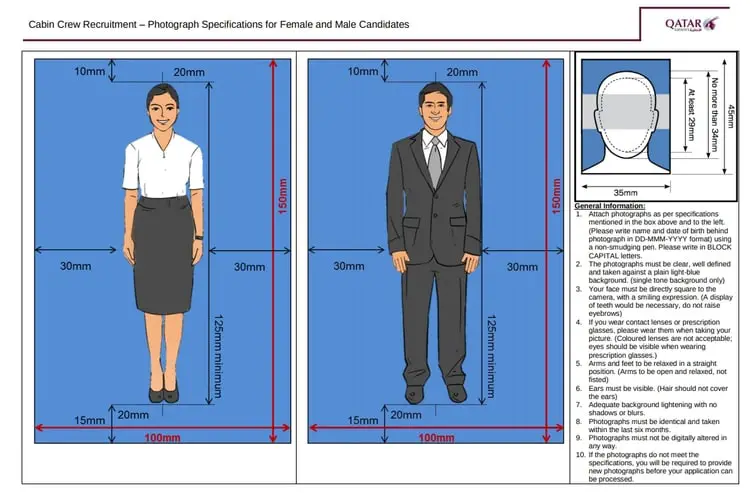
What kind of photo?
If you choose to add a photo, use a flattering headshot, taken against a white or light-colored, neutral background.
Personally, I think most passport photos are terrible to use because you can’t smile and they make you look up at that awkward angle, so maybe just a nice, professional headshot.
Don’t crop any photos as it’s very obvious and will look sloppy. Don’t forget to look the part!
Wear business attire, tie your hair up into a neat bun or ponytail, and apply some tasteful makeup.
Don’t forget to flash that million-dollar (or new hire probationary rate of $23 an hour) smile. 😁
Do I Need a Cover Letter?
While a cover letter is not necessary, it is recommended.
However, before you spend time writing one, check to make sure there even is an option for a cover letter submission. Some of the bigger airlines don’t even want them because the recruiters already have so much paperwork to sort through.
If it is an option, I would strongly recommend including it. A paragraph is sufficient, and I recommend keeping it a little more breezy and conversational than the actual resume.
Don’t include a ton of detailed information or make it sound generic, but do include a short intro of who you are and why you’re interested in the position.
A cover letter should give the recruiter a quick glimpse into the applicant’s personality, and why they want to work for their company. Each cover letter should be airline-specific, so mention the company by name and avoid copying and pasting the same cover letter for multiple airlines
A cover letter has other benefits too, such as explaining gaps in employment history or lack of experience. It could be used as a great tool to clear up any doubts about the resume.
Closing thoughts
In conclusion, remember that no matter your work background, I can promise that you already possess the necessary job skills! It’s just a matter of digging deep, doing the research on the airline’s core values, and expressing those wonderful personality traits into an elegant and well-crafted resume.
If you follow these guidelines, even without any experience as a flight attendant, you can ABSOLUTELY snag a career flying those friendly skies!
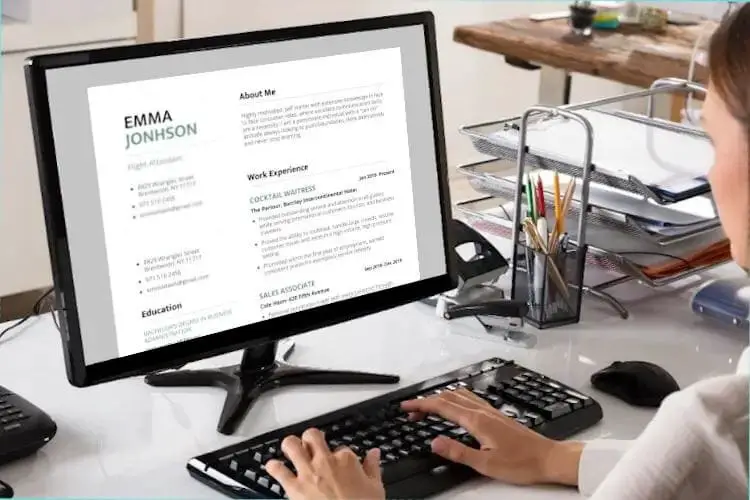
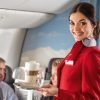
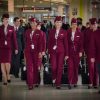



Thanks… This has really helped
I have been a middle school and high school teacher for 25 years. Just recently I became empty nest, and I have strongly considered flight attendant to be my next long term career. As an aspirin applicant to this exciting career, I find your information to be of great assistance during the application process. I am truly thankful for sharing your ideas as I truly believe it may lead me to be a potential applicant.
Thank you, it makes my day to read that 😊
Wow! Such exceptional advices and a well written journal. I learnt a lot of things, thank you so much!
This was a great article I love how you broke everything down, was so informative, best resume guide I have ever seen. I love your writing style, easy to read, little sass. Bravo 👏🏼